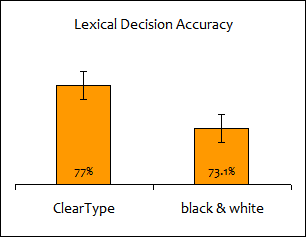ClearType improves our accuracy at recognizing words
Most people agree that ClearType makes text look nicer, especially when tuned. But does it help us read more efficiently? This is a difficult question because adult readers can read at a very fast rate – good readers can read 250-300 words per minute, which is a word every 200-240 milliseconds on average. Measuring something that takes less than a quarter of a second is a challenge.
Tachistoscopic Lexical Decision is a technique that has been used extensively to measure word recognition. Tachistoscopes were a mechanical device for presenting materials briefly, but have been replaced by computers. Readers are briefly shown either a regular word in their native language (e.g. distant) or a pseudoword (e.g. tadints), which is not a word in their native language. The reader’s task is to say if they saw a word or pseudoword. The advantage to this methodology it only requires the reader to complete a very simple task of pressing one button for words or another for pseudowords. This allows more accurate timing for word recognition.
The below animated image demonstrates what the reader sees during this task. The word and pseudoword here are appearing on screen for a longer period than in a typical study, but special software is needed to create shorter presentations.

A team led by Professors Lee Gugerty and Rick Tyrrell at Clemson University studied the effects of ClearType on the tachistoscopic lexical decision task. They asked 24 readers to respond to 280 words and 280 pseudowords. Half of the words were presented with ClearType rendering and half with the regular black & white rendering. They found that readers were statistically reliably more accurate at recognizing words when words were rendered with ClearType.

After correcting for guessing, this translates to a 17% accuracy improvement at recognizing words with ClearType than with black & white. This is a large difference in word recognition performance with a task that simulates the real world situation of looking at words for very brief periods of time.
Kevin Larson
Gugerty, L., Tyrrell, R. A., Aten, T. R. & Edmonds, K. A. (2004). The effects of subpixel addressing on users’ performance and preferences during reading-related tasks. ACM Transactions on Applied Perception, 1(2), 81-101.
Edit: Update Image Reference
Comments
Anonymous
October 28, 2005
That bar graph is kind of misleading, don't you think? Looks like a >50% improvement if you just look at the bars..Anonymous
October 28, 2005
It wasn't my intention to misrepresent the magnitude of effect, but rather was trying to zoom in on the two bars to make it clear that the error bars for ClearType and black & white do not overlap. A full scale would show lexical decision accuracy ranging from a low of 50%, or chance response, to a maximum of 100% accurate.Anonymous
March 03, 2006
Hi. My name is Bill Hill, and I’m one of the original inventors of ClearType. My job at Microsoft is...Anonymous
September 10, 2006
I have posted before on this issue, several times, in fact. And so have many others.
But now there...Anonymous
July 03, 2007
In particular, I don't. Lots of times other developers come over to me and look confused as they seeAnonymous
July 16, 2008
In two earlier posts I talked about studies that showed that word recognition is 17% more accurate andAnonymous
September 09, 2008
The comment has been removedAnonymous
March 15, 2009
fontblog : ClearType improves our accuracy at recognizing wordsAnonymous
March 19, 2009
  Internet Explorer 8 Beta 1에서 주소 표시줄에 대해서 실시한 몇가지  기술적인 안내 (도메인 하이라이트 기능, 여러 행 붙이기 기능, 클릭Anonymous
June 22, 2009
PingBack from http://tune-up-pc.com/blog/?p=2579Anonymous
June 22, 2009
PingBack from http://portal.lacaterinca.com/engineering-changes-to-cleartype-in-windows-7/Anonymous
June 23, 2009
PingBack from http://securityowned.com/engineering-changes-to-cleartype-in-windows-7.htmlAnonymous
June 25, 2009
PingBack from http://windows7info.net/engineering/engineering-changes-to-cleartype-in-windows-7/Anonymous
August 12, 2013
Again, it goes without saying that this is relative to black & white (e.g. no smooth edges in Windows), not gray scale anti-aliasing (e.g. "Standard" smooth edges in Windows).